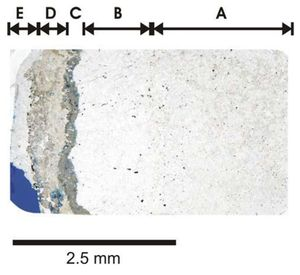OR/13/004 Upscaling from laboratory to repository scale: Difference between revisions
No edit summary |
m 1 revision imported |
(No difference)
| |
Latest revision as of 13:21, 10 November 2016
| Rochelle, C A, Purser, G, Milodowski, A E, Noy, D J, Wagner, D, Butcher, A, and Harrington, J F. 2013. CO2 migration and reaction in cementitious repositories: A summary of work conducted as part of the FORGE project. British Geological Survey Internal Report, OR/13/004. |
The experiments in this study were designed to simulate the potential upper and lower bounds of likely in-situ pressures and temperatures, and replicate specific scenarios as realistically as possible. We acknowledge however, that the experiments are relatively simple and have tightly-controlled conditions, and may therefore not replicate the complexities of ‘real’ systems. Also that there is a compromise in terms of timescales, as we were trying to simulate slow/low flow rate processes lasting 100s–1000s of years within a few months in the laboratory. Equally, we note that the sample sizes studied are far smaller than repository scale.
Upscaling of the processes identified by this study can be achieved by comparison with analogous systems. Whilst such systems may not have been studied in as much detail as the experimental samples of this study, they can provide information on temporal and spatial scales well in excess of those possible by experiment. Thus for example, in terms of physical size, for cement carbonation reactions there is very similar behaviour (qualitatively) with multi-metre scale observations of carbonated borehole cement from CO2-production wells (e.g. Carey et al., 2007[1]). Though the cement formulations may be different between those used as NRVB buffer-backfill and borehole seals, many of the phases involved and reaction processes appear similar in both cases. Though Carey et al. (2007)[1] do note a degree of alteration of the bulk cement, their results clearly demonstrate the importance of interfaces (steel-cement, and cement-rock) in facilitating CO2 migration, along which CO2 moved several metres in 30 years.
Extension of temporal scales to several thousands of years is possible through the study of analogous systems. Thus for example, modern borehole cements have been in use for a few 10s of years, Portland-type building cements 10s to approximately l50 years, Roman cements approximately 2000 years, other building cements up to approximately 5000 years, and naturally-carbonated naturally-occurring cement minerals for timescales of 10000s to 100000s of years. In relation to the current study, broadly comparable observations have been made of material from; carbonated borehole cements (Carey et al. 2007[1] — reactions over 10s years), and naturally-carbonated cement minerals reacted for >1000s years (natural analogues, Figure 15) (Rochelle et al., 2007[2]; Milodowski et al., 2009[3]). The size and age of some of these analogous systems are much closer to those required for repository assessments, and the similarity between observations of laboratory experiments and analogues leads us to believe that we can successfully translate many of them to repository scenarios.

Whilst some processes may behave similarly over a range of temporal and spatial scales, there are some notable differences. One of these appears to be the thickness of the carbonation interface. In the laboratory samples carbonated as part of this project it was possible to observe several discrete reaction fronts within a broader reaction zone. However, studies of naturally-carbonated naturally-occurring cement-type minerals (e.g. Milodowski et al., 2009[3], 2011[4]; Rochelle and Milodowski, 2013[5]) show a very narrow, single reaction front between carbonated and non-carbonated regions. It is possible that these differences are a function of the complex interplay between a series of reactions having very different rates, and we do not underestimate the difficulty in comparing these systems because of the very different CO2 partial pressures, state of the CO2, cement composition, CO2 ingress rates etc. Nonetheless, it does seem possible that differences in the relative rates of fluid flow and mineralogical changes have less of an impact as timescales increase, leading to narrower reaction zones over longer timescales. It is possible that these narrower zones may also become more efficient at sealing permeability. It would be useful to investigate further the permeability of the carbonation zones and how this changes over prolonged timescales.
References
- ↑ 1.0 1.1 1.2 CAREY, J W, WIGAND, M, CHIPERA, S J, WOLDEGABRIEL, G, PAWAR, R, LICHTNER, P C, WEHNER, S C, RAINES, M A, and GUTHRIE, J. 2007. Analysis and performance of oil well cement with 30 years of CO2 exposure from the SACROC Unit, West Texas, USA. International Journal of Greenhouse Gas Control, 1, 75–85.
- ↑ ROCHELLE, C A, MILODOWSKI, A E, SHI, J-Q, MUNOZ-MENDEZ, G, JACQUEMET, N, and LECOLIER, E. (2007). A review of the potential impact of CO2 on the integrity of well infrastructure for underground CO2 storage. British Geological Survey Commissioned Report, CR/07/204, 83p.
- ↑ 3.0 3.1 3.2 MILODOWSKI, A E, WAGNER, D, and LACINSKA, A. (2009). A natural analogue study of CO2-cement interaction: carbonate alteration of calcium silicate hydrate-bearing rocks from Northern Ireland. British Geological Survey Commissioned Report, CR/09/096, 28pp.
- ↑ MILODOWSKI, A E, ROCHELLE, C A, LACINSKA, A, and WAGNER, D. (2011). A natural analogue study of CO2-cement interaction: Carbonation of calcium silicate hydrate-bearing rocks from Northern Ireland. Energy Procedia, 4, 5235–5242.
- ↑ MILODOWSKI, A E, ROCHELLE, C A, and PURSER, G. (2013). Uptake and retardation of Cl during cement carbonation. Procedia Earth and Planetary Science, 7, 594–597.